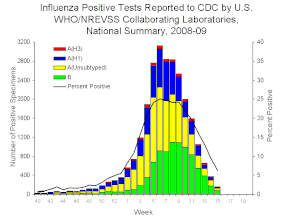| Influenza-like illness | |
|---|---|
 Proportion of positive influenza tests during a recent flu season. |
Preview warning: Page using Template:Infobox diagnostic with unknown parameter "1 = thumb"
Influenza-like illness (ILI), also known as flu-like syndrome or flu-like symptoms, is a medical diagnosis of possible influenza or other illness causing a set of common symptoms. These include fever, shivering, chills, malaise, dry cough, loss of appetite, body aches, nausea, and sneezing typically in connection with a sudden onset of illness.[1] In most cases, the symptoms are caused by cytokines released by immune system activation,[citation needed] and are thus relatively non-specific.
Common causes of ILI include the common cold and influenza, which tends to be less common but more severe than the common cold. Less common causes include side effects of many drugs and manifestations of many other diseases.[citation needed]
- ^ "Case definitions". European Influenza Surveillance Scheme. 12 December 2005. Retrieved 15 July 2009.